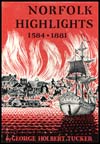Chapter 51
The Old Bells of Norfolk
Like their counterparts all over the country, the old bells of Norfolk once performed the important tasks of calling the faithful to worship, sounding distress alarms, tolling for calamities, or voicing exultation in times of civic or national rejoicing.
Now, with the exception of a few isolated examples, they are either mute or have been replaced by electronic devices that are poor substitutes for their pleasantly resounding peals.
What is believed to be the oldest church bell in Norfolk is in Christ and St. Luke's Episcopal Church at Olney Road and Stockley Gardens. This venerable tocsin was moved to its present position in the tall granite Gothic tower of the church from the steeple of Old Christ Church at Freemason and Cumberland streets in 1909.
The bell is inscribed "Christ Church" and weighs 1,218 pounds. It is forty-two inches in diameter, has "G" tone, and is provided with two clappers, one for tolling and one for ringing. It is rung by hand for the regular church services and is also tolled for funerals, a special device attached to the bell for the latter making it sound suitably mournful.
The Christ Church bell was cast in 1860 by the Meneely Bell Foundry in West Troy, N.Y., and replaced the original church bell dating from 1829. The latter was cracked in 1859, at which time it was part of the Norfolk City Clock that had been in the belfry of Old Christ Church since 1829. The second bell, the one now in use, was incorporated in the clock system to replace the original bell and remained in use there until Christ and St. Luke's was built, at which time it was transferred to its present place and the clock was given to the College of William and Mary in Williamsburg.
As far as is known, the first church in Norfolk to have a bell was the so-called "Bell Church," Norfolk's first Presbyterian church, erected in 1802 at Catharine (now Bank) and Charlotte streets. It is not known what happened to the bell that gave the church its name. Norfolk's second Presbyterian church was across the street from the present St. Paul's Episcopal Church. Originally it did not have a belfry, but around 1860, when it was restyled in the Gothic manner, a belfry was built and a bell was bought for it. But it was never hung.
At the outbreak of the Civil War, it was presented to the Confederate government to be melted down for military purposes. But the Yankees beat the Rebels to the draw. According to a letter received in Norfolk many years later, a native of Boston remembered seeing this bell carted through the streets of that city, bearing the placard, "This bell was captured from the Presbyterian Church in Norfolk, VA." The letter also added the fact that the bell wound up in the tower of a ferry house.
Two other old Norfolk bells deserve mention.
The bell of St. Mary's Catholic Church at Holt and Chapel Streets was cast in 1884 by the McShane Bell Foundry of Baltimore. It is forty-two inches in diameter, weighs 1,500 pounds, and is of "G" tone. It is still rung by hand to announce masses on Sunday and holy days of obligation, and it is also tolled for funerals. According to the centennial history of St. Mary's, published in 1958, the clock and bell of the church were supported at one time by public funds as a means by which Norfolkians of that neighborhood could regulate their daily activities.
The other bell is the Norfolk jail bell, currently perched on top of the motorcycle garage of the Public Safety Building. Inscribed "Joshua Register, Baltimore 1867," this old tocsin replaced an earlier one cast during the 1850s for the Gothic style Norfolk City Jail that was built during the same period on Avon Street behind the Norfolk City Hall and Court House, now the MacArthur Memorial.
The original bell, metal from which is incorporated in the present one, was cracked on January 1, 1863, when it was being rung to celebrate the Emancipation Proclamation.
Chapter
52
Other Distinguished Visitors
Norfolk Highlights 1584 - 1881

See the "Table of Contents" for links to every chapter in Norfolk Highlights 1584 - 1881 by George Holbert Tucker.
